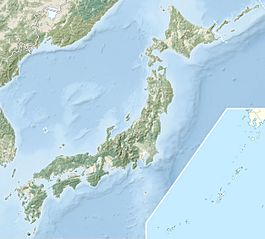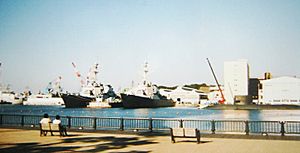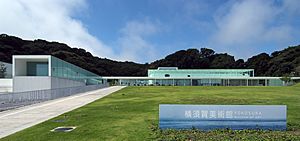Yokosuka facts for kids
Quick facts for kids
Yokosuka
横須賀市
|
|||
|---|---|---|---|
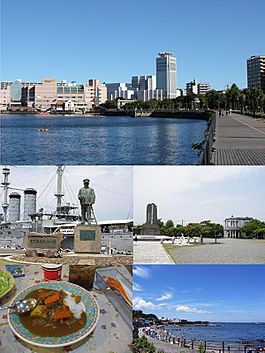
Top: View of downtown Yokosuka from Verny Seaside Park, Middle: Mikasa Battleship Monument and Heihachirō Togō Statue, Kurihama Matthew Perry Park, Bottom: Yokosuka Naval Curry, Kannon Cape, and seaside park (all item for left to right)
|
|||
|
|||
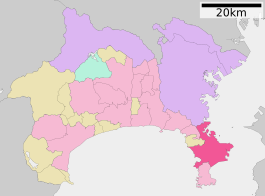
Yokosuka in Kanagawa Prefecture
|
|||
| Country | |||
| Region | Kantō | ||
| Prefecture | |||
| Area | |||
| • Total | 100.81 km2 (38.92 sq mi) | ||
| Population
(February 1, 2024)
|
|||
| • Total | 373,797 | ||
| • Density | 3,708/km2 (9,600/sq mi) | ||
| Time zone | UTC+09:00 | ||
| Postal code |
238-8550
|
||
| Area code | 14201-8 | ||
Yokosuka (横須賀市, Yokosuka-shi) is a lively city located in Kanagawa Prefecture, Japan. It sits on the Miura Peninsula, with beautiful views of Tokyo Bay and Sagami Bay.
As of February 2024, about 373,797 people live in Yokosuka. It is one of the biggest cities in the Greater Tokyo Area. Yokosuka is also famous for being home to a large U.S. Navy base.
Contents
- Exploring Yokosuka's Geography
- A Look at Yokosuka's History
- Yokosuka's Economy and Industries
- Population and People of Yokosuka
- Getting Around Yokosuka: Transportation
- Learning in Yokosuka: Education
- Community and Global Connections
- Fun Places to Visit in Yokosuka
- Famous People from Yokosuka
- See also
Exploring Yokosuka's Geography
Yokosuka covers most of the Miura Peninsula. It has the mouth of Tokyo Bay to its east. To the west, it faces Sagami Bay and the Pacific Ocean.
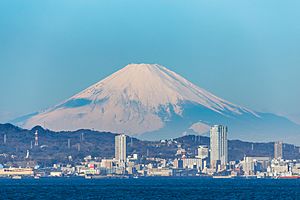
Neighboring Cities and Towns
Yokosuka shares its borders with several other places:
- Hayama
- Kanazawa-ku, Yokohama
- Miura
- Zushi
A Look at Yokosuka's History
Yokosuka has a long and interesting history, going back thousands of years.
Early History of Yokosuka
People have lived in the Yokosuka area for a very long time. Scientists have found old stone tools and pottery from ancient times. During the Heian period, a local leader named Muraoka Tamemichi built Kinugasa Castle in 1063. His family, the Miura clan, ruled this area for hundreds of years.
Later, an English sailor named William Adams arrived in Japan in 1600. He was the first British person to reach Japan. He landed in Uraga, which is part of modern Yokosuka. Because he helped the Tokugawa shogunate, he was given the title of samurai. You can find a monument to him in Yokosuka today.
During the Edo period, Yokosuka was very important. It was at the entrance to Tokyo Bay. All ships entering the bay had to stop there for checks. To protect Japan from foreign ships, the government built many coastal artillery batteries. However, in 1853, U.S. Navy Commodore Matthew Perry arrived with his "Black Ships." He landed in Kurihama, Yokosuka, which led to Japan opening up to the world.
The government decided to build a modern naval base in Yokosuka. They hired a French engineer, Léonce Verny, in 1865. He helped build the Yokosuka Naval Arsenal, which was Japan's first modern shipyard. This was a big step for Japan's industry.
Yokosuka from Meiji Period to Today
After the Meiji Restoration, the Imperial Japanese Navy took over the arsenal. Yokosuka grew, and in 1907, it officially became a city. The Yokosuka Line railway opened in 1889, connecting Yokosuka to Tokyo.
In the early 1900s, Yokosuka's naval base continued to expand. Many warships, including battleships and aircraft carriers, were built here. The Yokosuka Naval Air Technical Arsenal also developed and tested many planes for the navy.
The Great Kantō earthquake in 1923 caused a lot of damage to Yokosuka. Despite this, the city kept growing by adding nearby towns and villages.
During World War II, Yokosuka was bombed by American planes in 1942. However, it did not suffer much damage. Many tunnels and caves were built around the naval base for safety. These tunnels were used for secret work, hospitals, and factories. After Japan surrendered in 1945, American forces took over the naval base. The U.S. Navy has used it ever since.
Since the 1950s, United States Fleet Activities Yokosuka has been a home port for the United States Seventh Fleet. It played a key role in supporting the Korean War and the Vietnam War. The Japan Maritime Self-Defense Force also has a military port here. Because of these bases, many Americans and Filipinos live in Yokosuka.
In 2001, Yokosuka was named a core city. This means it has more control over its own local government.
Yokosuka's Economy and Industries
Yokosuka is an important industrial city. Its military facilities bring a lot of business.
Major Industries in Yokosuka
Nissan Motors has a large factory in Yokosuka called the Oppama plant. Thousands of people work there. Cars like the Nissan Leaf, Nissan Cube, and Nissan Juke are made at this factory. The plant started in 1961. It is next to Nissan's research center and a port where cars are shipped.
Every May, Yokosuka hosts a popular festival celebrating Japanese curry. About 50,000 people come to enjoy it each year.
Technology and Research
The Yokosuka Research Park opened in 1997. It is a big center for Japan's telecommunications industry. Many companies that work on wireless and mobile communication have their research and development centers here.
Population and People of Yokosuka
Yokosuka's population grew until around 1990, and then it started to slowly decrease. Many foreign citizens live in Yokosuka. These include people from the Philippines, Korea, China, and the United States.
| Historical population | ||
|---|---|---|
| Year | Pop. | ±% |
| 1920 | 96,351 | — |
| 1930 | 110,301 | +14.5% |
| 1940 | 237,523 | +115.3% |
| 1950 | 250,533 | +5.5% |
| 1960 | 287,309 | +14.7% |
| 1970 | 347,576 | +21.0% |
| 1980 | 421,107 | +21.2% |
| 1990 | 433,358 | +2.9% |
| 2000 | 428,645 | −1.1% |
| 2010 | 418,325 | −2.4% |
| 2020 | 388,078 | −7.2% |
Getting Around Yokosuka: Transportation
Yokosuka has good transportation options, especially by train and road.
Train Lines in Yokosuka
- JR East – Yokosuka Line
- Taura – Yokosuka – Kinugasa – Kurihama
- Keikyu Main Line
- Oppama – Keikyū Taura – Anjinzuka – Hemi – Shioiri – Yokosuka-Chūō – Kenritsu Daigaku – Horinouchi – Keikyū Ōtsu – Mabori-Kaigan – Uraga
- Keikyu Kurihama Line
- Horinouchi – Shin-Ōtsu – Kita-Kurihama – Keikyū Kurihama – YRP Nobi – Keikyū Nagasawa – Tsukuihama
Major Roads in Yokosuka
- National Route 16
- National Route 134
- National Route 357
Learning in Yokosuka: Education
Yokosuka has many schools for students of all ages.
Schools in the City
The city's public elementary and junior high schools are managed by the Yokosuka Education System. Many of the public high schools, like Yokosuka High School, are run by the Kanagawa Prefectural Board of Education. The city also has its own high school, Yokosuka Sogo High School.
Community and Global Connections
Yokosuka has special relationships with cities around the world.
Sister Cities of Yokosuka
Yokosuka is connected to these cities:
 Corpus Christi, Texas, United States (since 1962)
Corpus Christi, Texas, United States (since 1962) Brest, France (since 1970)
Brest, France (since 1970) Fremantle, Western Australia, Australia (since 1979)
Fremantle, Western Australia, Australia (since 1979) Medway, Kent, UK (since 1998)
Medway, Kent, UK (since 1998) Mazyr, Belarus (since 2008)
Mazyr, Belarus (since 2008) Bharatpur, Nepal, Nepal (since 2023)
Bharatpur, Nepal, Nepal (since 2023)
Friendship City
Yokosuka also has a friendship city relationship with:
 Aizuwakamatsu, Fukushima, Japan (since 2005)
Aizuwakamatsu, Fukushima, Japan (since 2005)
Fun Places to Visit in Yokosuka
Yokosuka offers many interesting spots for visitors and locals alike.
Islands and Historical Sites
- Sarushima is an island in Tokyo Bay that you can reach by ferry from Yokosuka. It's a great place to explore.
- The Mikasa is a famous warship preserved in Yokosuka. It was the flagship of Admiral Togo during the Battle of Tsushima. You can visit it as a museum and learn about its history.
Shopping and Entertainment
- "The Honch" is a popular area just outside the U.S. Naval Base. It's known for its shops and restaurants, and it's a favorite spot for both tourists and sailors.
- The Yokosuka Arts Theatre is a place where you can enjoy opera, concerts, and movies.
- Dobuita Street is near the U.S. naval base and has a strong American feel. Many shops accept U.S. dollars. In the evenings, it becomes a lively area with bars and clubs.
Unique Local Culture
- Yokosuka is known as the birthplace of sukajan jackets. These are special satin bomber jackets with embroidery, and they make a popular souvenir.
Famous People from Yokosuka
Many talented individuals, from politicians to artists and athletes, have come from Yokosuka.
Leaders and Public Figures
- Junichiro Koizumi, a former Prime Minister of Japan.
- Yoriko Madoka, a politician.
- Yūto Yoshida, a politician.
Artists and Entertainers
- Hitoshi Ashinano, a manga artist.
- hide, a famous musician.
- Kikuko Inoue, a voice actress.
- Kotaro Koizumi, an actor.
- Yōsuke Kubozuka, an actor.
- MAA, a singer.
- MadeinTYO, a rapper.
Sports Stars
- Isao Inokuma, an Olympic gold medalist in judo.
- Junya Ito, a football player.
- Mark Muñoz, a mixed martial artist.
- Rei Nishiyama, an Olympic gold medalist in softball.
- Cameron Thomas, a professional basketball player.
- Caol Uno, a professional mixed martial artist.
|
See also
 In Spanish: Yokosuka (Kanagawa) para niños
In Spanish: Yokosuka (Kanagawa) para niños




